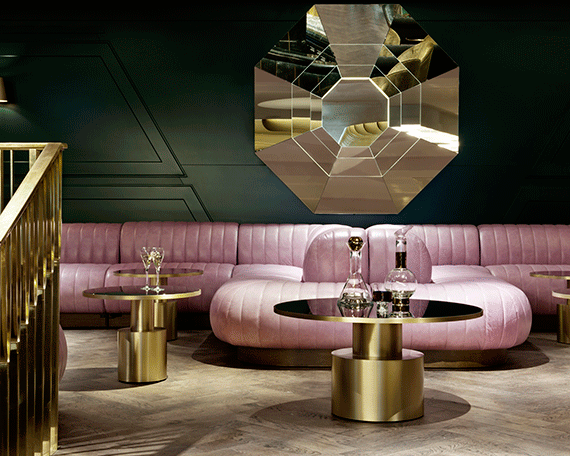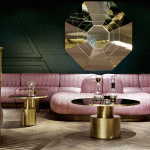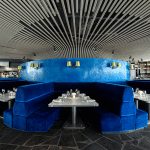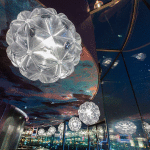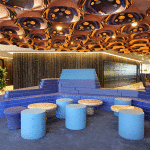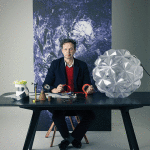“I don’t really fear failure,” shrugs Tom Dixon. “But what most creatives do fear is being found out. Being revealed as a fraud. We ask ourselves ‘Is my work really that good? Am I really that good?’ And I guess I do suffer from that.”
The legendary British designer pauses and looks out across his cavernous, semi-subterranean London store. Proof, if it was required, that he probably is that good. The combination of low brick ceilings and fading winter light is punctuated by the warm, copper glow of his trademark metallic designs.
It is the ultimate Thames-side treasure trove. An homage to 30 years of development, innovation and, by anyone else’s standards, success. But Dixon is not a fan.
“It looks like Aladdin’s Cave in here,” he says, wrinkling his nose disparagingly. “We need more space. Less metal. More colour. It needs softening. But even then it won’t be enough. Do I ever look around and think ‘I have arrived?’ No. Never. I always want to do more.”
And it is this drive that is pushing the 56-year-old former creative director of Habitat to put ambition firmly ahead of his fear of being found out. If a departure from metal was not change enough, then grand plans to move more towards office design, and even architecture, are likely to get people talking.
But Dixon is not starting from scratch in this sphere.
His practice, Design Research Studio, was behind the bold redesign of the McCann Erickson headquarters in New York in 2013 and the completion of the interior design of Interchange, a new co-working space in Camden, at the end of last year. And it is not beyond the realms of possibility that a Tom Dixon building could soon grace the London skyline.
Here, the man who began his design career welding metal in a car repair garage in Streatham talks trends, towers and the pleasure of saying no.
Music to metal
Had it not been for a series of motorcycle accidents in the early 1980s, Dixon’s life may have taken a very different path. “I broke my leg in the first accident,” he says nonchalantly. “I was at Chelsea Arts College and by the time I was ready to go back I just decided that, actually, I didn’t want to.”
After stints cleaning newspaper printing machines and working as a cartoonist, Funkapolitan – the band in which he played bass guitar – started to take off. Just as his life looked set to veer towards general rock stardom he had another motorbike accident, this time breaking his arm. And that was the end of his professional music career. “Was I put off motorbikes? No. I still ride them. But I have had about eight accidents now.”
The perils of two-wheel travel aside, these setbacks and injuries did Dixon’s eventual career path no harm. He learnt to weld “as part of a self-improvement plan” and found a hidden talent. “It was more like discovering a superpower,” he says.
“Making strong objects by fusing metals together to create structures. It was very immediate. It suited my impatience.”
Let it go
Just under 30 years later, Dixon runs a world-renowned design empire and has had to shift his focus from the collections to a wider strategy and growth plan.
“My time at Habitat as creative director forced me to stand back from the design itself,” he says. “That is so important. You have to let go a bit when you build a design business. You can’t just be a designer anymore.”
And his trick for coping with change? Decisiveness. “You have to learn to be decisive sometimes as a creative. And actually it is tough to be decisive and nice at the same time. I do sometimes compromise making decisions for that reason.” Any examples? None that Dixon is prepared to reveal. But he does have some advice: “Someone once said to me, ‘you have to learn that it can be a pleasure to say no’. And that is true. It is possible to make ‘no’ a pleasant experience. And I do always try to remember that.”
One thing he is not saying no to is working with property developers to build a portfolio in large-scale development. As the brains behind the interiors of Shoreditch House, N1, and the Mondrian London hotel at SeaContainers House, SE1, he has been building a reputation in the leisure sector since the early 2000s.
And offices are next on the agenda. “This shift of offices becoming more conducive to good design is something we spotted early with Shoreditch House,” he says. “What started off as an entertainment space soon became a work hub. What people want from their offices now is changing. They want to feel like they are hanging out in a great club. Where the coffee is better than anything they could get anywhere else. Like, 18 times better than at their previous workspace.”
It is this increasingly popular requirement from occupiers for a mixture of office space with a leisure twist that lends itself so well to Dixon’s style. And he knows the time is ripe to make the most of the demand. “Co-working and modern workspaces are now every developer’s obsession,” he says. “It is about creating a great, flexible space without being gimmicky. Revolutionising space does not mean doing away with formality entirely. You need some of that because ultimately these are still work places. I don’t think offices should become so relaxed that everyone is flopping around on beanbags holding a jar of cookies.”
Dixon’s designs instead bring together sleek, modern workstations with show-stopping design elements throughout. A copper orb light installation here, a space-age style seating area and chevron carpet there. “The difficulty is making sure the flexibility works,” he says. “You want these places to be pleasant. It is not just a theatre set. You need to have some solid, fixed items to make people feel comfortable.”
A new focus
Dixon’s shift in focus from the minutiae of design detail to office spaces in their entirety has resulted in a closer relationship with the property sector. And he knows what he is looking for when it comes to teaming up with the right people: “The best developers pick the most interesting designers to work with and to really move their businesses forward,” he says. “Some property companies are more interested and involved than others. Which is great. Though I do have some clients that lapse in to wanting to do the design themselves. I will not name any names.
“Ultimately I want to work with clients who want to help you, as the designer, really understand the operational side of stuff. Too many designers don’t really respect that side of it and it is important.”
Design Research Studio is currently working with Knight Dragon on the 2,000-acre Greenwich Peninsula Park scheme in Greenwich, SE10. And Dixon concedes that, while exciting, the project opened up a whole host of new challenges. “We have definitely realised that the really difficult stuff is working on projects that have not been built yet,” he says. “Working on a huge scheme like Greenwich where the towers are not even there yet? That is a challenge and working with a good client is crucial on these sorts of schemes.”
But even this has not put Dixon off wanting to broaden his horizons even further. All the way up to the towering heights of London’s skyline.
Towering ambition
“I would love to do some architecture,” he says. “Not just interiors. But the shell too. Or I would like to do some bridges. Bridges are great.”
So what exactly would a Tom Dixon-designed tower look like? “I don’t know but I know what it wouldn’t be. I can easily critique a lot of what is going on now. So much glass. And an absence of public space. I don’t mind The Shard. It is unique. And a couple of glass buildings is fine. But there are so many. And the multiplication of those glass buildings makes a very cold, unwelcoming city.
“Why can’t we mix the materials up? What about brick? Or timber? Vertical is something we all have to deal with but glass is for seeing through. Not for making a whole building out of. So my building would look different. It would depend where it was. I would either need a virgin plot or be given a building I do not like, and knock it down.”
Do any spring to mind? “Loads. But I don’t think it would be wise to say much more than that.”
Whether his grand plans are realistic, time will tell. Even with such a strong brand behind him, moving into full-scale architecture would be a huge undertaking. And no one is more aware of this than the man himself. But in what has now become a familiar show of pure grit, he refuses to let that derail his plans to give it a shot. “It is a dream. But lots of my dreams have come true so far.”
A fair point. Dixon has a habit of making the unlikely a reality. No doubt a product of luck, talent and a dose of steely ambition. That and always having to stay one step ahead of a constant fear of being found out.
• Click here to find out more about the EG Creative Spaces Award.







